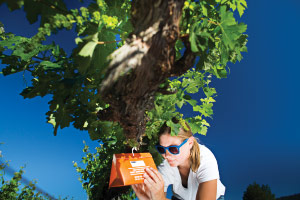How to Tell Pests to Stay Away
 |
|
In California, the benefit of preventing the glassy-winged sharpshooter, an insect pest, was estimated at $185 million. Photo by Elena Zhukova. Copyright 2013 The Regents of the University of California. Used by permission. |
ATTENTION PESTS: KEEP OUT. If only posted signs would scare the pests away. Exclusion, or prevention—it’s a fundamental principle of IPM, but why does it matter and how does one do it?
"Prevention is the practice of keeping a pest from infesting a field or a site," Jim Farrar and coauthors wrote in a paper about the adoption of IPM Practices.1
Prevention is the best defense, yet knowledge barriers often keep people from adopting IPM. A 2009 survey of growers revealed that fewer of them reported such barriers than previously recorded—between 8 and 23 percent, apart from the largest barrier, lack of knowledge, which 62 percent reported.
Reaping the Rewards of Prevention
To be sure, once the knowledge barrier is overcome, people readily choose a sustainable pest management approach, such as IPM. For a recent example in the headlines, public health officials around the world are showing interest in the sterile insect technique (SIT) to control mosquitoes before they transmit diseases such as Zika. In California, the benefit of preventing the glassy-winged sharpshooter, an insect pest, was estimated at $185 million. An online decision-aid system for Pacific Northwest tree fruit, meanwhile, is estimated to be worth $16 million annually in Washington state alone. In the Lodi wine grape-growing region of California, more than 50 percent of growers report using the IPM technique of leaf pulling to avoid insect, mite, and disease problems on grape clusters. Knowledge barriers fall as people seek out information from trustworthy sources, and society benefits from a greater, and more sustainable, biological security.
Preventing Weeds from Ever Starting
Eric and Anne Nordell own and operate Trout Run Farm, a two-person venture in Trout Run, Pennsylvania. They found that keeping weed pressure down before seeding crops helped significantly control weeds.
The Nordells employed two cover crops: winter hardy rye and sweet clover. The Nordells call their system "controlled rotational cover crops," which refers to their practice of rotating the timing and types of cover crops. Their efforts prevent weeds from becoming a problem before they start, and all in all reduce labor and material inputs. For details on the Nordell’s cover cropping system, see http://neipmc.org/go/TQaQ
Exclusion from Structures
For Jody Gangloff-Kaufmann, an entomologist at Cornell University and New York State IPM, exclusion is the number one pest management technique.
In 2015, the Northeastern IPM Center awarded her team, SCOPE 2020, a two-year grant to focus on excluding pests from residential buildings; the North Central IPM Center, meanwhile, sponsors a group working on commercial buildings.
Gangloff-Kaufmann’s team has developed an exclusion checklist for use in residential and commercial buildings, now in the testing phase.
"This checklist allows building managers to look at their building envelope and make sure it is pest-proof," says Gangloff-Kaufmann.
The Northeastern IPM Center publishes on its website an extensive collection of Best Management Practices, or BMPs, for excluding pests from structures. For these and other exclusion techniques, see http://neipmc.org/go/XGEN
The BMPs are targeted for use in schools, but the principles can be applied in many other settings. And the science certainly will serve you better than nailing up "Keep Out" signs for pests.
1 Farrar, J., Baur, M., and Elliott, S., “Adoption of IPM Practices in Grape, Tree Fruit, and Nut Production in the Western United States,” Journal of Integrated Pest Management, (2016) 7(1): 8; 1–8 doi: 10.1093/jipm/pmw007
— by CHRIS GONZALES
The Northeastern IPM Center promotes integrated pest management for reducing risks to human health and the environment. If republishing our news, please acknowledge the source (“From Northeast IPM Insights”) along with a link to our website.
